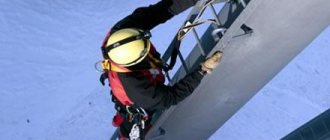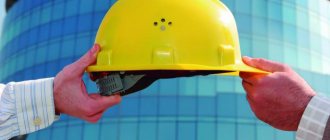On January 1, 2021, new rules for working at height came into force. We propose to trace the main changes in this area of hazardous work. (For the rest of the changes in labor protection rules from January 2021, see our article).
The document that consolidated these changes is the order of the Ministry of Labor and Social Protection of the Russian Federation dated November 16, 2020. No. 782n “On approval of the Labor Safety Rules when working at heights.”
Therefore, the orders in force up to this point are cancelled:
- No. 155n dated March 28, 2014 “On approval of labor protection rules when working at height”
- No. 383n dated June 17, 2015 “On amendments to the Labor Safety Rules when working at heights”
New Rules No. 782n are introduced for 5 years (until December 31, 2025). They can then be revised or canceled if necessary.
Such changes were necessary and expected. Our government is carrying out a reform of control and supervisory activities. The direction of this reform was approved in 2021. The task is the transition from comprehensive control (supervision) to differentiated control taking into account risks. The essence of a risk-based approach in any area is that control increases in high-risk areas, and decreases or is absent in safer areas. This allows you to take the necessary measures in a timely manner where it is required and significantly save resources.
Rules No. 782n are developed taking into account modern government guidelines and a risk-based approach to monitoring work at height. Here, inaccuracies have been eliminated and those issues that caused ambiguous interpretation when organizing work at height according to Rules No. 155n have been refined. The changes affected almost all sections of the Labor Safety Rules when working at height, valid until January 1, 2021.
Let's look at the changes in more detail using the example of paragraphs of Rules No. 782n.
We offer a comparative table for key sections, which shows the main differences between the new edition No. 782n and Rules No. 155n.
Here's what it looks like section by section.
General provisions
In the first section, the new Rules on labor protection when working at height draw the employer's attention to risk assessment in the control of work at height and the development of an occupational safety and health system in the form of separate regulations. This is reflected in points 4 and 6, which now look different.
An occupational safety and health management system (OSMS) is a set of interrelated and interacting elements that establish policies and goals in the field of occupational safety for a particular employer and procedures for achieving these goals. (Article 209 “Labor Code of the Russian Federation” dated December 30, 2001 N 197-FZ)
Read more about the occupational safety management system at the enterprise.
In the previous version of the Rules, paragraph 6 prescribed mandatory medical examinations for workers at height. Both upon entry to work (preliminary) and periodic medical examinations. This requirement is excluded from the new Rules.
The changes affected the registration of the permit. This is reflected in paragraphs 7 and 8 of Rules No. 782n.
Rules No. 155n (clause 11) listed work at height, which the employer is obliged to organize with the issuance of a permit. And paragraph 21 of Rules No. 155n was supplemented with requirements for issuing a permit for work at height in non-stationary places. In the new Rules, paragraphs of similar meaning have been revised and supplemented with an assessment of the risk of work.
The important difference here is that in Rules No. 155n (clause 11), the issuance of a work permit was determined by the group into which workers for the safety of work at height are divided. Now it is necessary to make a decision on issuing a work permit based on an assessment of the risk of a worker falling. According to the new Rules, for work with an acceptable minimum risk, a work permit may not be issued. This must be periodically repeated work, which is distinguished by the constancy of the place, conditions and nature of the work, collective protective equipment, is part of the technological process and is performed by a permanent staff of qualified performers.
Clause 9 of Rules No. 782n is new and concerns document flow in the field of labor protection. Allows for electronic document management in the field of labor protection. This clarification significantly reduces the burden on the manager of maintaining paper documentation at the enterprise.
Clause 11 establishes the scope of application of the new Rules, including in the design of facilities and the development of technological processes.
About paper expiration dates
The document is issued for a period of no more than 15 calendar days. The period is counted from the start of work. The assignment can be renewed only once for a period not exceeding 15 calendar days from the date of renewal. If there is a break in work, the permit remains valid.
In a situation where, during work, conditions are suddenly discovered that do not take into account the entries in the document, the responsible employee decides to stop the activity. The permit must be cancelled. Work can be continued only after drawing up and submitting a new document.
The validity of the document can be extended by the employee who issued it or by someone who has the appropriate authority.
Requirements for workers when working at height
In the second section, attention is paid to the qualifications, education and training of workers who take part in the organization and execution of work. The areas of responsibility of all participants in these works are delimited.
Workers who are allowed to directly perform work at height, carried out under a work permit, are, as before, divided into three work safety groups. The difference is that Rules No. 782n clearly indicate the division into employees who directly perform work at height and responsible persons. And separately, in paragraph 15, an important clarification was added about workers of group 3. Now the rules for working at height indicate the admission of this group of workers to the direct performance of work, but only subject to confirmation of qualifications and receipt of a certificate for the corresponding group.
The new version of the Labor Safety Rules when working at height for 2021 (Order No. 782n) establishes a ban on conducting training in safe methods and techniques for performing work at height in correspondence (distance) form. This prohibition is noted in paragraph 17, which also specifically mentions self-training internships, which are also now prohibited.
In the same section, paragraph 29 again deals with employee internships.
The responsibilities of employees of group 3 are explained in detail, the requirements for internship and periodic testing of knowledge of this group are clarified. The periodic testing of knowledge of employees of group 3 is noted in paragraph 33 of Rules No. 782n.
What documents need to be adjusted according to the new rules for working at height?
The new rules for working at height come into force on January 1, 2021. This means that occupational safety specialists need to make changes to the occupational safety instructions, training program and workplace briefing program.
Note! The Ministry of Labor has seriously changed the rules for working at heights. An occupational safety specialist urgently needs to study them; we advise you to pay special attention to the application of the results of occupational risk assessment in the organization. It now depends on them whether it is necessary to draw up a work plan (hereinafter referred to as WWP) for high-altitude work or whether it is enough to use a technological map (TC), whether there is a need to issue a work permit, or whether the work can be carried out without a work order. It also depends on the results of the risk assessment whether workers need to be assigned to work groups at height.
The employer, based on the results of the risk assessment, may decide to provide additional training to employees for groups of work at heights with a high risk of falling, especially for employees who climb to heights from scaffolding in conditions where there is a high risk of falls and injury.
Therefore, it is necessary to adjust and re-approve the list of high-risk work carried out under the permit.
Requirements for the use of safety systems for working at height
The scheme for providing workers with personal protective equipment (PPE) against falls from a height can be divided into 2 types:
- Personal PPE – issued directly to the employee.
- PPE on duty workers are assigned to a specific workplace and are on duty. They are not permanently assigned to one employee, but are transferred from one shift to another.
Such a system for issuing PPE was not previously described in Rules No. 155n. As amended by the Rules on Labor Safety when Working at Height dated January 1, 2021, paragraph 122 was added, which describes the procedures for issuing duty PPE. The main thing to remember is that only PPE with an operation indicator can be used as duty PPE.
This section also adds a requirement for anchor devices used in security systems.
Previously, there were several conflicting requirements for anchor devices. Rules No. 155n established requirements for the strength of such devices. At the same time, the strength of anchor devices in the restraint systems and safety systems differed (13.3 kN versus 22 kN).
It is known that on the territory of the Customs Union there is Technical Regulation of the Customs Union No. 019/2011 “On the safety of personal protective equipment”, which establishes requirements for such anchor devices. Certification tests are carried out according to the methods of GOST EN 795-2014 and GOST EN/TS 16415-2015, which set requirements for the strength of anchor devices at 15 kN.
Existing contradictions are eliminated in Rules No. 782n. Now the Rules stipulate that anchor devices are subject to mandatory certification (clause 129).
The new paragraph - 145 gives freedom in choosing anchor devices taking into account their characteristics.
A new provision on structural anchor has been included (clause 128); in the previous version of the Rules there was no such term.
Structural anchor - an element or elements permanently attached to a structure (building) so that an anchor device or personal protective equipment can be attached to it. (GOST EN 795-2014 “System of occupational safety standards (SSBT). Personal protective equipment against falls from a height. Anchor devices. General technical requirements. Test methods”)
Whereas previously anchoring locations were specified in the work plan at height and were determined primarily based on site inspections, the development of these plans may now require confirmation of the strength of structural anchors through strength calculations.
Organization of work at height according to the new rules: 13 main changes
Change No. 1. The classification of work at height has changed
The organization of work at height according to the new rules and the assignment of a group of work at height is now dependent on the fall risk identified during the occupational risk assessment. There is no longer a gradation of work “with the use of scaffolding” and “without the use of scaffolding”. If the risk is high, increased security measures are required. If your organization has not yet conducted a risk assessment, you need to hurry.
Read the article Professional Risk Assessment: Which Company to Engage >>>
Please note that if there has been no risk assessment at the enterprise, and work at height must be carried out as early as the first working day of 2021, the employer must organize safety measures for all high-risk work at height.
Note! When performing work at height, the choice of collective protective equipment and safety system must be justified by the results of a risk assessment and documented in the risk calculation.
Let's look at how safety measures differ depending on the risk of falling from a height:
Table. Requirements for working at height depending on the level of risk
| Risks | Requirements | Performance |
| Working with an acceptable minimum risk of falling from height | issuance of work permit | not required, work is carried out according to the technological map (TC) |
| responsible work manager | do not prescribe | |
| targeted training before work | do not carry out | |
| entry in the work log according to the work permit | no need to enter | |
| preparation of workplaces and permission to work | the employee conducts independently | |
| Work with a high risk of falling from height | issuance of work permit | required, work is carried out according to the work plan |
| responsible work manager | appointed, he is obliged to conduct targeted training with each member of the team | |
| registration of work permit | in the work log according to the work permit | |
| preparation of workplaces and permission to work | carried out by the responsible work manager and responsible executor |
permit: sample 2021
Change No. 2. When performing work under a work permit, a responsible work manager is appointed
Labor safety rules when working at a height of 782n now require the appointment of a responsible work manager in all cases of work performed under a work permit.
There was no such mandatory requirement in the rules that were in force until 2021. There was only a reservation: “may not be prescribed in cases determined by other regulatory legal acts in the field of labor protection.” For responsible work managers, the employer is obliged to organize special training at the training center with assignment to group 3 of work at height.
Change No. 3. The new rules differentiated who can be assigned 1, 2, 3 groups, and in what case one employee can have several groups at once
An employee with group 3 who is going to directly perform work at height must additionally be assigned:
- group 1 – for a team member
- group 2 – for the foreman
There was no such requirement in the canceled rules. It was believed that if an employee has group 3, he can repair damage himself as a member of a team or a foreman, and he does not need to additionally obtain a certificate for group 1 or 2.
Now in paragraph 14 of the new rules there is a clear distinction for performing work at height: workers directly performing work at height with groups 1 and 2, and workers with group 3.
Change No. 4. Prohibition of correspondence and distance learning and internships, as well as self-training for workers in groups 1 and 2.
The new rules introduce a direct ban on training in safe methods and techniques for performing tasks exclusively in a remote format. The training program must include practical exercises to develop the necessary skills.
The very fact that clause 17 appeared in the rules reflects our reality. Just ten years ago it was impossible to imagine that electricians, industrial climbers, pipeline installers or antenna mast operators were trained in heights exclusively in a distance format or by correspondence.
Working at height is a dangerous type of work, and fall injuries most often lead to the death of the worker or his disability. Therefore, it is important to practice trouble-free actions during practical exercises, on a mock-up, learn how to properly attach the anchor device, and check the cable on the safety harness for wear.
Note! Assignment of groups is carried out exclusively by the training center. The employer has the right to conduct only annual training on safe techniques for performing work at height in its commission, but groups cannot be assigned within the organization. The internship can also be carried out only on a full-time basis.
Change No. 5. Allowed to perform work at height under unfavorable conditions
According to the new rules for working at height, from 2021 it is allowed to carry out work in unfavorable climatic conditions, in poor visibility and icing, when installing structures with large windage, which were previously prohibited. This is most likely due to the need to carry out construction work at height.
It is precisely because of these changes that for all high-altitude work it is necessary to appoint a responsible work manager, develop a work plan, issue a work permit and conduct targeted training for each member of the team, in addition to using systems to ensure the safety of workers: fences, safety harnesses or other means of collective protection specified in PPR
Change No. 6. Certification of safety and rescue systems has been clarified
the anchor device is also subject to mandatory certification to TR CU 019/2011 . Now the employer can organize work at height if he has a valid certificate of compliance with the Technical Regulations of the Customs Union 019/2011 for safety systems.
Table. What requirements must security systems meet?
| Safety system | Requirement |
| Protective helmets | must have a system of fastenings on the head that does not allow spontaneous falling or displacement from the head |
| Fall arrest systems | the force transmitted to a person at the moment of a fall when using a safety harness should not exceed 6 kN |
| Components and connecting elements of safety and restraint systems | must withstand a static load of at least 15 kN, and slings made of synthetic materials - at least 22 kN |
| Components of fall arrest systems with a retractor type device | must withstand a static load of at least 12 kN |
| PPE against falls from height | must have a design that excludes: — back injury when performing work, including in uncomfortable positions — a person falling out of personal protective equipment — spontaneous disconnection of connecting elements of personal protective equipment |
| PPE against falls from height | must withstand the dynamic load that occurs when a load weighing 100 kg falls from a height of 4 m, 2 m and 1 m |
| Carabiner design | should prevent accidental opening, as well as prevent pinching and injury to hands when working with it |
| Connection materials | must be resistant to corrosion, metal parts should not be in direct contact with the human body, except for hands; |
For personal rescue devices (ISU), additional safety requirements are established:
- must ensure efficient and safe use by any user, regardless of the architectural complexity of the building (structure), and be constantly ready for use;
- must exclude rotation and the possibility of free fall of the user during the descent, as well as a sudden stop of the descent;
- the descent speed in the ISU must be ensured automatically and not exceed 2 m/s;
- must be able to establish the fact of use in order to prevent reuse
Note! The manufacturer, in the operational documentation for personal protective equipment against falls from a height, must indicate the total length of the safety system with a lanyard, including a shock absorber, end connections and connecting elements, climatic conditions of use, and for the fall protection system, additionally indicate the maximum height of descent.
Change No. 7. Regulated the requirements for the content of the technological map
Requirements have been established for the technological map for work with a minimum acceptable risk of falling from a height, carried out by workers without a work permit and assignment of groups of work at height.
Previously, the requirements were specified only for PPR. But paragraphs 36-42 of the new rules contain requirements for technological maps. Therefore, study all these requirements and edit your technological maps, and if these maps do not exist, you need to develop them.
Change No. 8. Updated requirements for the content of the action plan for the evacuation and rescue of workers
A rescue and evacuation action plan must be developed in accordance with the Regulations on the occupational safety management system in your organization (OSMS). This provision should contain a section “Responding to accidents, accidents and occupational diseases” . This is the requirement not only of paragraph 43 of the new rules for working at height, but also of paragraphs 60-64 of the Model Regulations on the Occupational Safety and Health Management System dated August 19, 2016 No. 438.
Developed on the basis of the section “Responding to accidents, accidents and occupational diseases” of the OSH regulations, the action plan for the evacuation and rescue of workers is an integral annex to the work plan.
Change No. 9. Allowed to work from portable ladders with power tools
Labor safety rules when working at a height of 782n no longer prohibit working with power tools from ladders if safety measures have been taken and special conditions have been formalized in the work permit . At the same time, for such work it is now necessary:
- appoint a responsible work manager
- develop PPR
- issue a permit
- conduct targeted training for each team member
- apply systems to ensure the safety of workers (fences, safety harnesses or other means of collective protection specified in the PPR).
Change No. 10. Specialized calculation in PPR or TC
One of the most important innovations in the organization of work at height is the application to the work plan or technological map of a specialized calculation of the load in the anchor device.
In the old rules, such a calculation in the form of a separate document was not required. The calculation must be made taking into account the requirements in Appendix No. 11 to the new rules. In order to calculate the load, it is necessary to know the number of team members, the distances between the anchoring points and the diameter of the rope, as well as its characteristics.
Change No. 11. Test frequency for ladders and stepladders has been established
In the canceled rules No. 155 n such frequency was not indicated. According to the new rules for working at height, the following testing frequency for ladders and stepladders must be observed:
- Once every 6 months for wooden stairs and stepladders
- Once a year for metal stairs
After the test, it is necessary to apply a stamp indicating the number, date of the test and affiliation with the unit. During the inspection of the unit, the safety specialist must check the maintenance of the test report for ladders and stepladders and the presence of stamps.
Change No. 12. Additional requirements for the operation of cradles have been established
The new rules prohibit more than two workers from lifting in a cradle. It was also prohibited to combine 2 cradles into one, and to use a barrel of water as ballast. The rules prohibit access to winches by unauthorized persons. Cradles cannot be used in winds exceeding 10 m/s and in poor visibility. The occupational safety specialist needs to make changes to the occupational safety instructions, the training program and the workplace briefing program.
Change No. 13. Additional requirements for the operation of scaffolding and scaffolding were established.
The new rules have an additional requirement: in the place where workers climb onto scaffolding and scaffolding, the locations of anchor lines must also be indicated. The angle of inclination of scaffolding ladders should be no more than 75 degrees to the horizontal surface and the slope of the ladder should be no more than 1 to 3.
Labor protection requirements when working on antenna mast structures
The Rules for Labor Safety when Working at Height, as amended by Order No. 782n, eliminate strict restrictions when working on antenna mast structures when the voltage is not removed and in difficult weather conditions. Clause 297 establishes compliance with a number of conditions necessary to carry out such work.
In northern climate zones, antenna mast structures and other objects are constantly covered in ice, so previously we had to face some difficulties when working at height. The new requirements give more freedom of action for the work organizer, but do not relieve the employer of responsibility for organizing and observing safety measures for working at height in special conditions.
These are the main changes to the Labor Safety Rules when working at height, Order No. 782n, which affected the most frequently used topics during such work. The full version of the new Rules No. 782n can be found at the link, order of the Ministry of Labor and Social Protection of the Russian Federation dated November 16, 2020. No. 782n “On approval of the Labor Safety Rules when working at heights”
Important!
When new labor protection rules are introduced, all employees of organizations, regardless of their organizational and legal form of activity, must undergo an extraordinary knowledge test (clause 3.3 of Procedure 1/29)
Resolution of the Ministry of Labor of the Russian Federation and the Ministry of Education of the Russian Federation of January 13, 2003 N 1/29 “On approval of the Procedure for training in labor protection and testing knowledge of labor protection requirements for employees of organizations” (with amendments and additions)








